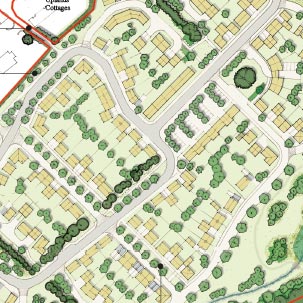Services
We provide planning advice across a wide range of development types, over a considerable geographic area, for a range of clients in the public and private sectors. This includes residential and commercial developers, retailers, private landowners, local authorities, charities and smaller private clients.
Our Philosophy
The pressure on local authorities to produce more housing has increased in the past few years and continues to do so. Successive governments propose housing targets in a way that becomes ever more focussed on individual local authorities and the ‘punishments’ for failing to produce sufficient housing merely make it less likely that a local authority can provide a sufficiently timely supply of new sites that corresponds with local views that often run counter to ambitions to produce the right housing in the right place. Imposition of targets merely makes local populations more hostile. Government imposed Standard Methods of identifying housing needs in individual local authority areas continues as a national strategy but solves little. Expect a revised NPPF in early 2025 with further updates and targets. The struggle to meet five-year housing targets means that some local authorities are overwhelmed and find themselves on the wrong site of appeal debates about the presumption in favour of development in the NPPF.
At ASP, we are more than familiar with the way in which the planning system fails to meet the demands placed upon it, not merely in terms of housing numbers but in terms of the ever-increasing detailed level of information required to be provided, and the increasing emphasis placed upon it. In rural Districts and Counties, the constraints make positive planning difficult or impossible, and the perception of developers remains at the lowest ebb – the enemy. At the other end of the spectrum, the failure of some local authorities to produce up to date local plans, and to rely on policies that are sometimes 20 years old and practically irrelevant to solving today’s conundrums cannot be the right way to manage a system.
We see this in all the areas in which we operate – throughout the southeast and East Anglia, as well as farther afield. Our present portfolio of work includes consultancy advice on residential schemes of varying sizes and in a wide range of locations. Our role in most cases is as lead consultant, reporting directly to the client, formulating and implementing a tactical approach and managing a larger development team of specialist consultants. Current residential development instructions range from one or two units up to proposals for around 400, in a range of local authorities in Kent, Surrey, East and West Sussex and East Anglia.
The requirements of the planning system increase year on year in an ad hoc way as each fresh initiative comes into being. Biodiversity Net Gain is a relatively new introduction, but the regulations regarding its creation and management have been a shambles.
But what is our part in all this, as a consultancy seeking to achieve a better outcome than before and a consensus view between all those engaged in the system/ It is to try to occupy a middle ground and to seek to produce developments that meet the requirements of clients and can be found acceptable locally with careful explanation and understanding. We like to think we achieve that.


Residential
Like many planning consultancies, we find ourselves dealing in a wide range of residential development proposals. For us, they range between one house and hundreds. Often, we advise individuals on proposals for a new house for themselves, where it is necessary for us to ensure they understand the system they will have to negotiate and the many pitfalls that are possible. We have a good relationship with many small local housebuilders, with proposals for up to ten units, and a very successful record. More ambitiously, we also deal with much larger proposals. In 2024, for instance, we have achieved a resolution to grant planning permission for 340 houses for a promoter and have an application submitted for 250 houses for a landowner. At this scale, development proposals are team-based efforts, with ASP acting as project manager.

Commercial
We deal with a range of proposals in the commercial area also, from small, client-based requirements to a proposal we presently have on our books for a new 21,000m2 (225,000ft2) business park, the allocation of which we secured through a Local Plan.
Other development
We have for a number of years acted for a number of different caravan site operators with portfolios of sites, seeking to achieve upgrades in facilities and improving operational criteria. We have also been involved in applications for the provision of new residential and holiday sites all over the country.
In addition to all of the above, we deal with all other aspects of development where our services can be brought into play. That includes matters such as Enforcement and Lawful Development Certificates and other areas where expertise is required in planning law.
Permitted development (PD)
Substantial changes have been made to the permitted development rules over the last few years, and that has led to the opening up of opportunities that did not previously exist. As time has gone on, the PD changes have expanded exponentially, and in almost every case there are caveats and conditions that have to be taken into account in a highly detailed way to ensure the correct path is followed. In many ways, the most difficult question we have to answer is “do I need planning permission for…”
We constantly looking at existing clients’ portfolios to see whether PD rights can be used to advantage, as well as advising new clients in the same way. There is relevance in the use of permitted development rights in establishing ‘fall back’ positions, where it is sometimes possible, through a mix of PD and application proposals, to achieve development that it might otherwise not be possible to gain permission for.
Planning Appeals
We presently also have a heavy workload of planning appeal work, often derived from cases in which we have not been involved at application stage. This includes written representations, informal Hearings and Public Inquiries. We are able to directly instruct counsel and have good contact with the major planning Chambers.
Other Work
We also have a range of work on a more diverse range of development types including applications for Lawful Development Certificates, and in a range of enforcement matters. LDCs can often be of significant importance to a client’s interests, both in terms of securing a ‘fall back’ position and in providing a tactical basis from which to launch other proposals.